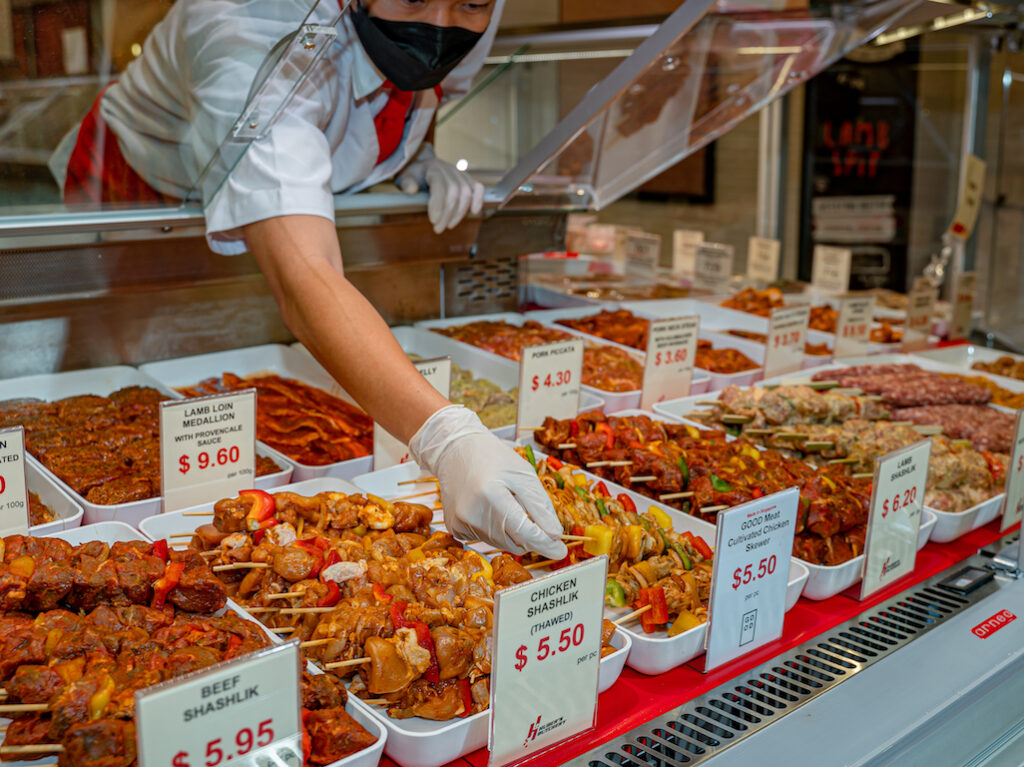Most People Who Have Tried Cultivated Meat Say They’d Eat It Again, But Taste & Price Parity Remain Key
8 Mins Read
In a first-of-its-kind in-market study of cultivated meat, a majority of consumers who have tasted Eat Just’s Good Meat chicken say they’d do it again. However, delivering on flavour and bringing down costs are the most important factors influencing consumption, highlighting the industry’s primary challenges.
For many diners headed to Huber’s Butchery and Bistro in Singapore last spring, conventional meat wasn’t on their mind. Instead, they were hoping to join an exclusive club of people who have tried cultivated meat globally.
At the time, Singapore was the only country to have approved the sale of these products (the US would follow soon in the summer). Huber’s, for its part, was the world’s first butchery to offer cultivated meat to customers, serving Good Meat’s chicken in the form of kebabs and as part of salads and pastas.
Today, as Eat Just works on restarting its production run in Singapore to be able to manufacture larger amounts of cultivated chicken, these novel proteins aren’t currently available at Huber’s, or any other restaurant in the world, for that matter (though that will change soon). In the face of increased political challenges, high costs, and production bottlenecks, the industry stands at a crossroads.
Many have written cultivated meat off, including figures in the media as well as government, despite most of them never actually having eaten the food themselves. That’s a huge problem: how can you truly make your mind up on something you haven’t done? And for companies in the space, the only way to find out how these products are performing is to ask the people who’ve tried them.
This is exactly what researchers from the Singapore Management University (SMU) did last year, surveying 107 diners at Huber’s between April and June, who had tasted one of its dishes containing Good Meat’s cultivated chicken. Published in the peer-reviewed journal Future Foods this week, the study sought to assess if presenting the chicken in the context of a familiar meal, in a familiar setting, would influence them to buy it again, and recommend it to others.
Here’s what they found.
A majority of cultivated chicken tasters would eat it again

The survey found that 88% of people were first-time tasters of cultivated chicken, with the rest having done so either at a Good Meat trial, at Huber’s or fellow eatery 1880, or via a Foodpanda delivery. On a scale of 1 to 5, the poll revealed that the acceptance of cultivated meat was high (4.19), while scores of their knowledge about the production (3.5) and benefits (3.53), as well as familiarity (3.58) were similar.
But the striking results were in the post-consumption stage, with the researchers finding that buying and eating cultivated meat “significantly boosted” people’s acceptance of it, with diners expressing a strong willingness to try it again (a score of 4.41/5) and recommending it to loved ones (4.45/5). In terms of flavour, survey participants scored Good Meat’s chicken with 4.21 out of 5, but fewer consumers believed others would order cultivated meat at restaurants (3.67/5).
The research also explored consumption drivers and barriers. As is the case with plant-based meat, taste stood out as the factor most important for people to consume cultivated meat again, with 58% saying so. This was followed closely by price (50.5%) and health (49.5%). However, only 35.5% of consumers said safety would play a role in determining whether they repurchase cultivated meat.
“This particular finding may simply demonstrate a trust in regulatory agencies to ensure the safety of food that is approved for sale and consumption,” Eat Just’s head of global communications, Carrie Kabat, tells Green Queen. “In both countries, where [Good Meat’s] cultivated meat has been approved, we have worked closely with regulatory agencies over multiple years to create a rigorous and transparent safety review process, and we are glad to see consumers demonstrating trust in that framework.”
Interestingly, it seems that putting cultivated meat in a familiar dish doesn’t matter much to people, with only 17% finding this important.
Cultivated meat needs to be cheaper

In terms of deterrents, however, cost is overwhelmingly the biggest issue with cultivated meat. While Kabat says Eat Just prices its chicken similarly to conventional chicken dishes on menus (between S$4 and S$23, or $3-17), 63.5% of diners would find high markups a turnoff. All other factors are less important here, including safety (33%), flavour (30%), texture (25%) and health (16%).
Reflecting on taste as a factor for repeat consumption and price as a potential barrier, Kabat notes: “This demonstrates that while we’ve been able to create a delicious product with similar protein content to conventional chicken, our sharp focus on reducing costs and increasing efficiencies in production is also a crucial element to driving consumer acceptance and adoption.”
Production costs and capacities are consistently the two biggest obstacles to the commercialisation of cultivated meat. Eat Just itself had a challenging 2023 with legal and financial battles, and has currently frozen mass production plans, explaining that factory prices need to halve. Speaking to Axios earlier this week, co-founder and CEO Josh Tetrick said bringing down production costs “will require new thinking in how these facilities are built”, and that the company has “not solved for that”. Confirming that Eat Just is sticking to low levels of production, he added: “I can’t emphasise enough just how small the volumes are.”
When asked how Eat Just can overcome this issue, Kabat says: “Our Good Meat team is focused on process development work to bring down costs and increase efficiencies. This includes things like increasing cell densities and finding ways to reduce the cost of our growth media, as well as rethinking how to build large-scale manufacturing facilities for a much lower price tag.”
This is an issue illustrated by Elliot Schwartz, a principal scientist at alternative protein think tank the Good Food Institute (GFI). “The question is: how do we increase cell density while simultaneously decreasing media costs?” he said in a webinar on Wednesday. “I don’t think we actually know the cost of cultivated meat production. There are a lot of different production scenarios and approaches being pursued, and so a single number really is hard to provide.”
Schwartz noted that context is important when discussing costs in comparison to conventional meat, given that many cultivated meat companies enter the market through hybrid meat (which combines cultivated meat with plant-based ingredients). Good Meat’s chicken, for example, mixes its cultivated product with wheat gluten, soy protein, sunflower and coconut oils (among other natural flavours and binders).
“If companies are pursuing commodity meats such as chicken, pork, beef, and certain seafoods, then hybrid products at low inclusion rates offer the most tractable way to approach cost-competitiveness,” said Schwartz. “However, the timeline is uncertain.”
On its website, Good Meat says it has reduced production costs by 90% since 2018, when operating a built-for-purpose plant. Previous analysis by Reuters has claimed that cultivated meat needs to reach production costs of $2.92 per pound to compete on price with conventional meat. And while startups have cut manufacturing costs by 99% in less than a decade, McKinsey estimates that it will still take until 2030 for it to reach price parity.
‘Socialise’ cultivated meat to influencers and expats

The researchers suggested that cultivated meat startups could benefit from conducting tasting trials with selected restaurants “to socialise cultivated meat to innovators and early adopters such as food neophiles and social media influencers”, and targeting expats and well-travelled natives, who are likely to be more global and open in their outlook and consumption preferences.
Additionally, they advised companies to focus their brand messaging on flavour, both on its own as well as part of familiar meals and dishes. “While a familiar meal preparation could increase willingness to try, the good taste (i.e. gustation) of a product is essential for fostering its regular consumption,” they wrote.
“We undertook this study because it represented an unprecedented opportunity to study consumer reactions in an actual consumption setting,” said Mark Chong, a professor of communication management at SMU and co-author of the study. “Our findings scientifically validate the importance of sensory experience (e.g. through product trials) and tastiness to consumers’ repeat consumption of cultivated meat.”
GFI APAC managing director Mirte Gosker concurred, highlighting that flavour has to hit the mark. “This data shows that cultivated meat can pass that high bar and turn sceptics into enthusiasts, so now we need costs to come down enough to enable such products to reach the masses,” she said. “That’s going to require greater global collaboration, market access, and investment, but Singapore has made clear that it’s open for business and ready to meet this moment.”
This will likely benefit Eat Just, which remains “singularly focused on achieving cash flow break-even in 2024”, according to Kabat. The city-state will also provide more openness and freedom compared to the US, the other country where it is approved to sell its cultivated chicken, where legislators have been trying to ban these foods.
With just one signature away from governor Ron DeSantis, Florida is very close to doing so. But it has met with pushback from not just cultivated meat companies, but even traditional meat groups, with the largest trade association in the US labelling it as “bad policy” that “limits consumer choice”. Kabat and Eat Just have a similar view. “Restricting consumer choice because of a desire to avoid competition is about as un-American as it gets,” she says.
“Our biggest learning from the study is that when consumers are free to buy and eat cultivated meat, they are much more likely to accept it and suggest it to their friends and family,” she adds. “We have seen over and over again that when people try cultivated meat, they realise it’s just like the chicken they’ve eaten many times before. We’ll continue our work to improve our processes and make more cultivated meat so that even more people have a chance to discover this for themselves.”




